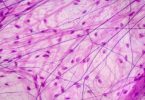The toad possesses
(a) Bifid tongue, slippery skin and mucous glands
(b) Salivary glands, mucous glands and parotid glands
(c) Parotid glands, warty skin and semicircular snout
(d) Slippery skin, yellow pigment and abundant mucous glands
In frog, the vein that carries blood from tongue is termed
(a) Lingual
(b) Azygous
(c) Cutaneous
(d) Anterior abdominal
The lungs in frogs are
(a) Compact spongy masses
(b) Thin-walled elastic, hollow bags
(c) Thick-walled nonelastic, hollow bags
(d) Thick-walled nonelastic solid masses
Metamorphosis in frog can be promoted by
(a) Iodine
(b) Chlorine
(c) Phosphorus
(d) Calcium
Related: Economic importance of Bacteria Questions
Fenestra ovalis in frog is the
(a) Air-filled cavity of middle ear
(b) Communication between pharynx and tympanic cavity
(c) External opening of tympanic cavity covered by tympanic membrane
(d) Opening of auditory capsule which separates middle ear from internal ear
The medulla oblongata of the brain passes out through
(a) Foramen obturator
(b) Foramen magnum
(c) Foramen of Magendie
(d) Foramina of Luschka
In frog, the surface of attachment of tongue is
(a) Palatine
(b) Sphenoid
(c) Pterygoid
(d) Hyoid apparatus
The first pair of lymph hearts in frog pumps the lymph into
(a) Femoral vein
(b) Subclavian vein
(c) Subscapular vein
(d) Hepatic portal vein
Related: Group 17 Elements (Halogens Family) MCQ
What is the main difference in human and frog RBC?
(a) Human RBC are non nucleated
(b) Haemoglobin is found only in human RBC
(c) Human RBC have nucleus
(d) Human RBC are multinucleate
One of the main functions of frog’s skin is
(a) Diffusion of respiratory gases
(b) Absorption of ultraviolet rays to produce vitamin D
(c) Storage of excess food in the form of subcutaneous fat
(d) Excretion of nitrogenous waste in the form of uric acid
The second cranial nerve of frog is distributed in
(a) Retina alone
(b) Lens and retina
(c) Iris and eye muscles
(d) Eye muscles and retina
Heart of frog differs from that of man by presence of
(a) Two aortae
(b) Mitral valve
(c) Sinus venosus
(d) Four-chambers
Related: Test Your Knowledge About Birth Control
Male frogs can croak louder than females because being
(a) Vocal sacs
(b) Stronger
(c) Larger in size
(d) Larger sound box
Dissection of frog is done from ventral side because
(a) Ventral skin is soft
(b) Abdominal vein is present ventrally
(c) Vertebral column is present on dorsal side
A frog must swallow air to expand the lungs because frog
(a) Has no diaphragm
(b) Has no vagus nerve
(c) Is relatively primitive vertebrate
(d) Normally breathe though its skin
Related: Online Test for Morphology Of Angiosperm
Which of the following is not a median part in the brain cavity of frog?
(a) Iter
(b) Diocoel
(c) Metacoel
(d) Optocoel
In frog pyloric sphincter is located between
(a) Fundus and pylorus
(b) Cardiac and fundus
(c) Oesophagus and pharynx
(d) Stomach and duodenum
A Bidder’s canal in each kidney of frog
(a) Runs longitudianally in lateral region of the kidney
(b) Runs longitudianally in medial region of the kidney
(c) Runs tranversely across the width of anterior part of the kidney
(d) Runs transversely across the width of posterior part of the kidney
Oxygen carrier or the respiratory pigment in the blood of a frog:
(a) Myoglobin
(b) Cytochorome
(c) Haemoglobin
(d) Haemocyanin
In frog, which of the following structures are related with gaseous exchange:
(a) Gills & skin
(b) Lungs
(c) Buccopharyngeal cavity
(d) All the above
The ciliated funnels on the ventral side of the kidney in frog are called
(a) Ostia
(b) Nephrostomes
(c) Corpora adiposa
(d) Bidder’s organ
Frogs have the ability to climb because they possess:
(a) Claws
(b) Adhesive skin
(c) Adhesive pads on fingers and toes
(d) Glue like secretion from mucous gland
Related: Group 18 Elements (Noble Gases) Quiz
Which of the following is mainly used in capturing the prey in frog?
(a) Lips
(b) Teeth
(c) Tongue
(d) Hand
In frogs, cutaneous respiration takes place
(a) Always
(b) Only on land
(c) Only in water with pulmonary respiration
(d) Only in water pulmonary respiration is not occurring
The functional kidney of frog tadpole is
(a) Pronephros
(b) Archinephros
(c) Mesonephros
(d) Metanephros
Related: Stoichiometry Multiple Choice Questions and Answers
Chromatophores in frog’s skin are controlled by
(a) Hormones
(b) Environment
(c) Nervous activity
(d) Nervous and hormonal activities
In frog, jelly around the eggs is deposited in
(a) Ovary
(b) Oviduct
(c) Water after fertilization
(d) Water during fertilization
Digestion of fats occurs mostly in
(a) Rectum
(b) Stomach
(c) Duodenum
(d) Small intestine
Nitrogenous excretory product of tadpole of frog is
(a) Urea
(b) Guanine
(c) Uric acid
(d) Ammonia
Related: Skin Anatomy & Physiology Quiz
The body of a frog is divisible into
(a) Head and trunk
(b) Head, neck and trunk
(c) Head, neck, trunk and tail
(d) Head, neck, thorax, abdomen, tail
In frog
(a) Acetycholine is the only neurotransmitter
(b) Noradrenaline is the only neurotransmitter
(c) Both acetycholine and noradrenaline act as neurotransmitters
(d) Neither acetycholine nor noradrenaline acts as neurontransmitter
When a sperm enters an egg of frog?
(a) First polar body is formed
(b) First meiotic division occurs
(c) Second meiotic division occurs
(d) Fertilization process is completed
The heart of frog consists of
(a) Two auricles and one ventricle
(b) One auricle and two ventricles
(c) Two auricles and two ventricles
(d) One sinus venosus, one auricle and one ventricle
What is not found in the skin of a frog?
(a) Scales
(b) Epidermis
(c) Mucous glands
(d) Poison glands
Related: Tongue Questions and Answers
Which structure is not concerned with breathing in frog?
(a) Skin
(b) Lungs
(c) Diaphragm
(d) Buccal cavity
Conus arteriosus is a part of the heart because
(a) It has valves
(b) It has cardiac muscles
(c) It is a part of atrium
(d) It is connected to ventricle






